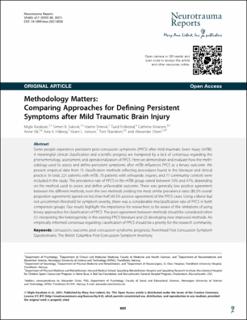| dc.contributor.author | Karaliute, Migle | |
| dc.contributor.author | Saksvik, Simen Berg | |
| dc.contributor.author | Smevik, Hanne | |
| dc.contributor.author | Follestad, Turid | |
| dc.contributor.author | Einarsen, Cathrine Elisabeth | |
| dc.contributor.author | Vik, Anne | |
| dc.contributor.author | Håberg, Asta | |
| dc.contributor.author | Iverson, Grant L. | |
| dc.contributor.author | Skandsen, Toril | |
| dc.contributor.author | Olsen, Alexander | |
| dc.date.accessioned | 2022-02-21T13:58:18Z | |
| dc.date.available | 2022-02-21T13:58:18Z | |
| dc.date.created | 2022-01-20T22:47:19Z | |
| dc.date.issued | 2021 | |
| dc.identifier.citation | Neurotrauma Reports. 2021, 2 (1), 603-617. | en_US |
| dc.identifier.issn | 2689-288X | |
| dc.identifier.uri | https://hdl.handle.net/11250/2980573 | |
| dc.description.abstract | Some people experience persistent post-concussion symptoms (PPCS) after mild traumatic brain injury (mTBI). A meaningful clinical classification and scientific progress are hampered by a lack of consensus regarding the phenomenology, assessment, and operationalization of PPCS. Here we demonstrate and evaluate how the methodology used to assess and define persistent symptoms after mTBI influences PPCS as a binary outcome. We present empirical data from 15 classification methods reflecting procedures found in the literature and clinical practice. In total, 221 patients with mTBI, 73 patients with orthopedic injuries, and 77 community controls were included in the study. The prevalence rate of PPCS in the mTBI group varied between 10% and 47%, depending on the method used to assess and define unfavorable outcome. There was generally low positive agreement between the different methods; even the two methods yielding the most similar prevalence rates (89.2% overall proportion agreement) agreed on less than half (45.5% positive agreement) of the PPCS cases. Using a liberal but not uncommon threshold for symptom severity, there was a considerable misclassification rate of PPCS in both comparison groups. Our results highlight the importance for researchers to be aware of the limitations of using binary approaches for classification of PPCS. The poor agreement between methods should be considered when (1) interpreting the heterogeneity in the existing PPCS literature and (2) developing new improved methods. An empirically informed consensus regarding classification of PPCS should be a priority for the research community. | en_US |
| dc.language.iso | eng | en_US |
| dc.publisher | Mary Ann Liebert Publishers Inc. | en_US |
| dc.rights | Navngivelse 4.0 Internasjonal | * |
| dc.rights.uri | http://creativecommons.org/licenses/by/4.0/deed.no | * |
| dc.title | Methodology Matters: Comparing Approaches for Defining Persistent Symptoms after Mild Traumatic Brain Injury | en_US |
| dc.type | Peer reviewed | en_US |
| dc.type | Journal article | en_US |
| dc.description.version | publishedVersion | en_US |
| dc.source.pagenumber | 603-617 | en_US |
| dc.source.volume | 2 | en_US |
| dc.source.journal | Neurotrauma Reports | en_US |
| dc.source.issue | 1 | en_US |
| dc.identifier.doi | 10.1089/neur.2021.0028 | |
| dc.identifier.cristin | 1986983 | |
| dc.relation.project | Samarbeidsorganet mellom Helse Midt-Norge og NTNU: 90130700 | en_US |
| dc.relation.project | Stiftelsen Dam: 2016/FO77679 | en_US |
| cristin.ispublished | true | |
| cristin.fulltext | original | |
| cristin.qualitycode | 1 | |

